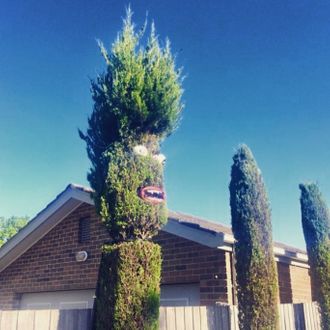
The Instagram that Instagram wants you to see is populated by aspirational gloss. It’s almost-famous models and fitness freaks who know their best angles; travel photographers seeking perfectly staged-but-unstaged photos; and food bloggers consuming as much cheesy food and rainbow whatevers as possible. Like so much of the internet, it ostensibly creates space for unlimited voices, but instead encourages a collapsing aesthetic. It ends up presenting a narrower view of the world.
Then there are accounts like Shit Gardens, which primarily documents the quirky landscaping of Melbourne, Australia’s working-class suburbs. (About 30 percent of its posts aren’t of Melbourne, occasionally veering off into subjects like a newt posed like a go-go dancer pressed up against a glass box.) Through strange topiary, sometimes bizarre and other times silly statues, tree faces, and mailbox-eating sharks, it showcases a particular fusion of more classic elements (Greco-Roman, Zen gardens) with an eccentric sensibility. (And, also somewhat regularly, dinosaurs.) Photos are given clever one-liners for captions. “Sliding into them DMs like …” is paired with a photo of a kid sitting at the top of a slide that’s at a 90-degree angle. Another of a weathered Dolphin statue reads, “If you look closely, there’s some bird shit just above the Dolph’s eye.”
Thanks in large part to its algorithm and popularity-contest format, which, like other social media, encourages the Pursuit of Likes, Instagram is a homogeneous social network. But it also encourages that kind of homogeneity in real life. It’s enforced a sameness to the aesthetic of restaurants — puns written out in neon signs! Colors that pop! — and their food, over-the-top dishes that are not meant to be eaten but snapped. It also facilitates the rapid spread of trends. If you’re running a Western restaurant in Shanghai and want to know what’s cool in New York, you don’t need to book a flight. You just need to click on hashtags. The world might be round, but it’s flattening like a balloon that’s been popped. In a time when you can’t tell the difference between cafés and apartments from Tokyo to Copenhagen to Brooklyn, Shit Gardens celebrates something peculiar, particular, and not particularly distinguished.
“I think we felt that suburban Melbourne and its gardeners had a very unique approach,” says James Hull, an English and history teacher who was roped into starting the page by Bede Brennan, a landscape architect. “We’re not doctorates or anything. We’ve studied a little bit of history, a little bit of philosophy, this and that. There’s a sense of homage to a lot of ancient Greek and Roman cultures, and in front yards it is often quite dramatic. There’s just these interesting narratives that spring up from the gardens.”
The duo approaches, Hull says, these spaces with a good-natured sense of humor. “The tagline on the page has always been ‘a celebration not a condemnation.’ The essence has always been we’re celebrating these gardens, not making fun of people,” Hull says. By Shit Gardens, he elaborates, they don’t literally mean shit, but bizarre, wonderful, and fun to look at it. “It’s about how much these gardens just enrich and liven up our suburbs that can otherwise be a little bit boring.”
Hull and Brennan are childhood friends who moved to Melbourne, and conceived the idea about eight years ago as a joke Tumblr during college. Since then, it’s attracted over 34,000 followers who want to look at photos like one of a laconic dog sitting in an old, round tub of water, or topiary modeled after Oscar the Grouch (“Oscar the misanthropic Pinophyta”); it’s also bled over into the real world, with Hull and Brennan putting on exhibitions at Melbourne galleries and creating a book with independent publisher Knock Knock. The book has seven idiosyncratic chapters, each one focused on a pattern Hull and Brennan have observed. Things like urban Zen, AstroTurf (“It’s very kitsch and Melbourne”), and another devoted to water fixtures. “That’s one of our favorites because you get all sorts of strange ones, most of them not having any water at all,” Hull says.
You could call Shit Gardens part of the broader Internet Ugly aesthetic, but it’s really more specifically part of something native to this app: Ugstagram. It’s a term you can apply to other users, like Chill Wildlife, an aggregator for amateur videos of animals being weird and funny; Ugly Design, which catalogues not-well-designed household objects; and Cooking for Bae, “a sweet dedication to struggle plates” that collects photos of gross and/or poorly cooked food.
Other accounts, like You Did Not Sleep There, poke at Instagram’s aspirational gloss; it specifically collects shots from travel photographers and #vanlifers who post photos of ludicrously impractical but very photogenic campsites on the edges of cliffs, rocky beaches facing mountains, and other locations. Less intentionally, there’s Cacti Explorer, which is just a guy’s watermarked photos of cacti that look like they’d be paired with a botanist’s field notes and are odd and against the grain.
What Instagram is famous for — enough that you might feel shamed out of posting photos, unless you’re a dad, that aren’t good — is that pretty, glossy, FOMO-inducing look. The contrast with accounts like Shit Gardens is as hard; Internet Ugly, the Tumbler look, and old-school glitch art all reference an earlier, shittier-looking stage of the internet. Instagram never went through that; it was born ready for #vanlife. It was always about a world that was artificially nice, and the app’s nature meant that a narrow slice of the world would be presented through it. The content being crammed into our craniums all feels very overengineered, and these accounts feel like a tongue-in-cheek reaction to that, as fuzzier, rougher underground rock in the ’80s was to overproduced, engineered pop music of that time.
The photos they post on Shit Gardens are fine. They don’t look professional, high resolution, or painstakingly framed, more like what you would’ve snapped around the dawn of smart phones. In other words, they don’t glamorize their unglamorous material. It’s something else that Hull says distinguishes Shit Gardens from similarly minded pages devoted to brutalist architecture that he and Brennan follow. In a later email, he cited #BRUT Group and This Brutal House as “both incredible but void of anything in the way of humor.”
“Even the way these pages are set up and done in such a beautiful way. The layout of the page itself is very neat and tidy. With us, it’s about creating an aesthetic that sort of has a bit more self awareness and can actually laugh at itself and thrives off laughing at itself,” Hull says. Later over email he added, “If I had to compare our page with any of the pages that we follow, I’d say that the closest thing to us would be RuralMurals69 [editor’s note: nice] or Kasimir Pillè’s carpet_sample.”
It goes without saying that Instagram wasn’t made for close-up, context-less shots of carpets. Hull and Brennan aren’t driven by algorithms or virality, either, and Shit Gardens doesn’t exist or need to exist for any particular reason other than genuine appreciation. It happens to be a particularly good version of this as well as, probably, the internet’s No. 1 tutorial on how not to do topiary. But it’s exactly the account’s tongue-in-cheek focus on the odd gardening of just one city that gives it a more universal appeal. And there’s nothing shit about Shit Gardens.






























